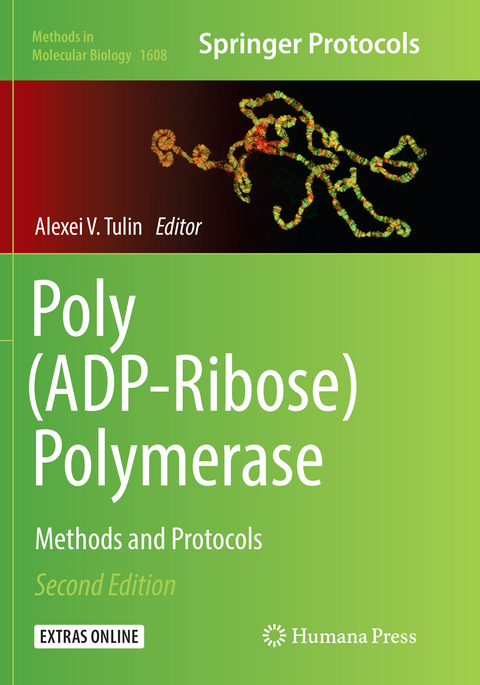
Poly(ADP-Ribose) Polymerase
Humana Press Inc. (Verlag)
978-1-4939-8361-2 (ISBN)
Authoritative and practical, Poly(ADP-Ribose) Polymerase: Methods and Protocols, Second Edition serves as an ideal companion to the first edition for scientists whose investigations involve this important pathway.
The chapter 'Identifying and Validating Tankyrase Binders and Substrates: A Candidate Approach' is published open access under a CC BY 4.0 license.
Quantitation of Poly(ADP-ribose) by Isotope Dilution Mass Spectrometry.- Quantification of PARP Activity in Human Tissues: Ex Vivo Assays in Blood Cells and Immunohistochemistry in Human Biopsies.- Detecting and Quantifying pADPr In Vivo.- Compartment-Specific Poly-ADP-Ribose Formation as a Biosensor for Subcellular NAD Pools.- Cell Cycle Resolved Measurements of Poly(ADP-ribose) Formation and DNA Damage Signaling by Quantitative Image-Based Cytometry.- Detecting Protein ADP-Ribosylation Using a Clickable Aminooxy Probe.- ADP-Ribosylated Peptide Enrichment and Site Identification: The Phosphodiesterase-Based Method.- Using Clickable NAD+ Analogues to Label Substrate Proteins of PARPs.- Identification of Protein Substrates of Specific PARP Enzymes Using Analog-Sensitive PARP Mutants and a ‘Clickable’ NAD+ Analog.- Identification of ADP-Ribose Acceptor Sites on In Vitro Modified Proteins by Liquid Chromatography – Tandem Mass Spectrometry.- Proteome-Wide Identification of In Vivo ADP-Ribose Acceptor Sites by Liquid Chromatography –Tandem Mass Spectrometry.- Poly(ADP-Ribose)-Dependent Chromatin Remodeling in DNA Repair.- Methods to Assess the Role of Poly(ADP-Ribose) Polymerases in Regulating Mitochondrial Oxidative Function.- Approaches for Investigating Translational Regulation Controlled by PARP1: Biotin-Based UV-Crosslinking and Luciferase Reporter Assay.- Methodology to Identify Poly-ADP-Ribose Polymerase 1 (PARP1) – mRNA Targets by PAR-CLiP.- Biochemical and Biophysical Methods for Analysis of Poly(ADP-Ribose) Polymerase 1 and Its Interactions with Chromatin.- PARP-1 Interaction with and Activation by Histones and Nucleosomes.- Strategies Employed for the Development of PARP Inhibitors.- High-Throughput Colorimetric Assay for Identifying PARP-1 Inhibitors Using a Large Small-Molecule Collection.- Testing PARP Inhibitors Using a Subcutaneous Murine Xenograft Model.- In Vitro Long Term Proliferation Assays to Study Antiproliferative Effectsof PARP Inhibitors on Cancer Cells.- Use of Inosine Monophosphate Dehydrogenase Activity Assay to Determine the Specificity of PARP-1 Inhibitors.- The Use of PARP Inhibitors in Cancer Therapy: Use as Adjuvant with Chemotherapy or Radiotherapy, Use as a Single Agent in Susceptible Patients, and Techniques Used to Identify Susceptible Patients.- Purification of Recombinant Human PARP-3.- Purification of Recombinant Human PARG and Activity Assays.- Studying Catabolism of Protein ADP-Ribosylation.- Purification of DNA Damage-Dependent PARPs from E. coli for Structural and Biochemical Analysis.- Identifying and Validating Tankyrase Binders and Substrates: A Candidate Approach.- Computational and Experimental Studies of ADP-Ribosylation.
| Erscheinungsdatum | 18.08.2018 |
|---|---|
| Reihe/Serie | Methods in Molecular Biology ; 1608 |
| Zusatzinfo | 47 Illustrations, color; 35 Illustrations, black and white; XV, 528 p. 82 illus., 47 illus. in color. |
| Verlagsort | Totowa, NJ |
| Sprache | englisch |
| Maße | 178 x 254 mm |
| Themenwelt | Naturwissenschaften ► Biologie ► Biochemie |
| Naturwissenschaften ► Biologie ► Mikrobiologie / Immunologie | |
| Schlagworte | DNA repair • enzymatic activity • pADPr • PARP-1 • PARP inhibitors • Protein acceptors |
| ISBN-10 | 1-4939-8361-X / 149398361X |
| ISBN-13 | 978-1-4939-8361-2 / 9781493983612 |
| Zustand | Neuware |
| Haben Sie eine Frage zum Produkt? |
aus dem Bereich


